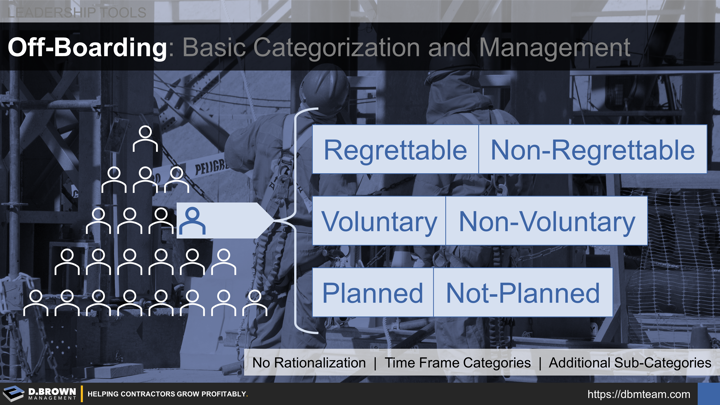From terminations to retirement, people will leave your team. Managed correctly, the off-boarding process can improve every other aspect of your Talent Value Stream (TVS) including:
- Planning
- Recruiting
- Onboarding
- Retention (Management & Development)
BASIC CATEGORIZATION
- Regrettable (Or Not?): For whatever reason they are leaving, do you feel regret that they are no longer with the company based on the value they were adding? Don't confuse emotions around their departure with their value-add. Also, be cautious not to mistake this for legacy value-add. Instead, focus on current value-add and future potential value-add.
- Voluntary (Or Not?): Did they leave on their own, or were they terminated (fired or laid-off)? Don't mis-categorize those that were politely handled as resignations, or where they quit just before they were about to be fired.
- Planned (Or Not?): Did you get to control the timeline or was it controlled by the employee who was leaving or some triggering event such actions well outside behavioral boundaries?
Be cautious to avoid rationalizing things away due to the normal emotions around any sort of relationship split. Develop processes that include multiple inputs and looking back at factual history like evaluations and 1:1 meeting notes to properly categorize. The data is useless if it is not objective.
You can break things down into additional subcategories. For example, a termination is different than a layoff due to lack of work.
Time frame categories can also be valuable as the metrics should look very different for people with less than 90 days with the company and less than two years.
Improvements start with analyzing the information and digging into the details. Remember that these metrics are just a proxy for the details. You have to dig a lot deeper asking questions that help you see the entire causal tree that led to the outcomes.
- If you are routinely losing good people (Regrettable) because of work fluctuations requiring layoffs (Non-Voluntary but Planned), then perhaps you need to look at your market strategy or opportunity development process. Perhaps you need to cross-train some of the best to take other roles. Construction talent is in short supply so they will go where there is steady work.
- How good is your labor forecasting for project backlog? How far in advance are you seeing the peaks and valleys to plan?
- Can you help place those people at other companies with an agreement for their return when work picks back up?
- Are there patterns with certain job roles or managers? Perhaps the job role isn't clearly defined or has unrealistic expectations. If one person quits a manager, it is likely them. If multiple people quit, it is likely the manager.
- If you are losing people and they are "Non-Regrettable" then why weren't they proactively removed earlier?
- For those that are "Non-Regrettable" it means that they were falling short of the company's standards for performance and/or behaviors in a material way. Could that have been seen earlier in the recruitment screening process? How?
- If people are retiring, how are you managing the off-boarding process so that they can ease into retirement and out of their existing role giving them more time to transfer knowledge and add value?
These are just some basic questions to get you started improving your entire Talent Value Stream (TVS).

